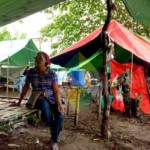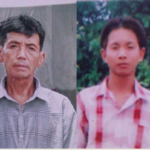Seamus Martov / The Irrawaddy, April 21, 2014
MAI JA YANG, Kachin State — A week of fighting between Kachin Independence Organization (KIO) forces and Burmese Army troops has left more than 5,000 people displaced in eastern Kachin and neighboring Shan states, according to an aid group involved in relief efforts there.
“About 60 percent” of the 5,000 who are estimated to have been displaced are receiving some form of help from NGOs and relief groups, according to Naw Din, a senior staffer with Karuna Myanmar Social Services (KMSS), a group affiliated with the Burmese Catholic church. Approximately 1,800 refugees are staying in the government-controlled town of Man Win Gyi and another 1,000 are across the border in China, but the situation is precarious for the latter displaced population, facing pressure from authorities to return to Burma.
The rest of the newly displaced are sheltering in KIO-controlled areas or have congregated in Muse and other areas in northwestern Shan State, said Naw Din. Most of the refugees are ethnic Kachin or Palaung, but many Shan have also been displaced.
According to Naw Din, who is currently based in Kachin State’s Bhamo Township, a government decision to close the roads linking Bhamo to Loije and Man Win Gyi has made it very difficult for aid groups to send relief to those in need. UN agencies including Unicef have been unable to transport their aid from warehouses in Bhamo to Man Win Gyi because of the road closures. “If they can procure aid locally, they should,” added Naw Din, who said he doesn’t expect the roads to be opened any time soon.
Mary Tawm, coordinator of the Mai Ja Yang-based relief organization WPN, told The Irrawaddy that although the fighting appeared to have reduced over the past 48 hours, the humanitarian situation remained serious. “I am very worried and concerned for the IDPs
It is unlikely that many more of the recently displaced refugees will be able to return home any time soon, said Mary Tawm. The areas in southeastern Kachin State’s Mansi Township and neighboring areas from which the refugees fled continue to be highly militarized, explained the aid worker, who along with her colleagues has provided humanitarian services to affected populations since the fighting began.
More than 100,000 people are estimated to have been displaced in total since June 2011, when a 17-year ceasefire agreement between the government and the KIO broke down.
The recent wave of clashes, which began on April 10, appears to be the most serious since early 2013, when KIO and government troops engaged in heavy fighting near Laiza, the KIO’s Kachin State headquarters. In an interview broadcast on April 16, presidential spokesman Ye Htut confirmed to the Burmese-language service of Voice of America that during the fighting the government Army lost several soldiers including a “senior commander.” Ye Htut called on KIO troops and their leadership to show “restraint in this situation.” The request came despite the fact that the losses were sustained during a Burmese Army offensive against KIO positions.
The recent fighting also appears to have involved government forces that were dispatched to the area last month to provide what state media described as “assistance” in conducting the UN-funded census in the region. The census was not carried out in KIO territory after the rebel group declined to take part.
The latest armed confrontation coincided with a visit by one of the KIO’s top officials, Gen. Gun Maw, to Washington, DC, last week. The popular Kachin leader, who serves as vice chief of staff for the KIO’s armed wing, the Kachin Independence Army (KIA), in addition to acting as his group’s point man in ongoing peace negotiations with the central government, appears to be the most senior KIO official ever to visit the United States.
While in Washington, Gun Maw met with several senior officials from the US State Department, including Assistant Secretary of State for Democracy, Human Rights and Labor Tom Malinowski and US Permanent Representative to the United Nations Samantha Power. He also met with officials from the National Security Council, USAID, and the Department of Defense, according to a statement issued by the State Department over the weekend.
“In our meetings with General Gun Maw, we expressed firm US support for the post-ceasefire peace process, which will have to tackle long unresolved political grievances,” said the State Department’s Malinowski in the statement.
“The balance between central and local authority, inclusion for all in national and local political processes, constitutional reform, equitable sharing of natural resources, and humanitarian access to internally displaced people are just a few of the issues that must be negotiated in good faith for a ceasefire to lead to durable peace,” Malinowski said.
Gun Maw’s visit to Washington is also significant due to the fact that none of his counterparts from Burma’s other armed rebel groups appears to have visited the United States since the nominally civilian government of Burma’s President Thein Sein took office in March 2011.
Kachin Civilian Shot, Recovering
Aung Nan, a 31-year-old Kachin man, is recovering in hospital in Bhamo after allegedly being shot by government forces at a checkpoint in eastern Kachin State on Wednesday of last week. According to Naw Din, the carpenter was on his way to work in Lung Hkat when he was shot as he approached a checkpoint near Dagaw at about 9am. The man was seriously injured in the incident.
“The Army side thought that he was KIA or something like that, but actually he is only a civilian,” said Naw Din, whose group is providing financial support for Aung Nan’s medical treatment.
Following the shooting, Aung Nan explained that he had approached the checkpoint unaware of the recent escalation in fighting.
“He thought it was a normal situation. That’s why he tried to go back to the area,” Naw Din said.
This news article originally appeared on The Irrawaddy. See the original here.

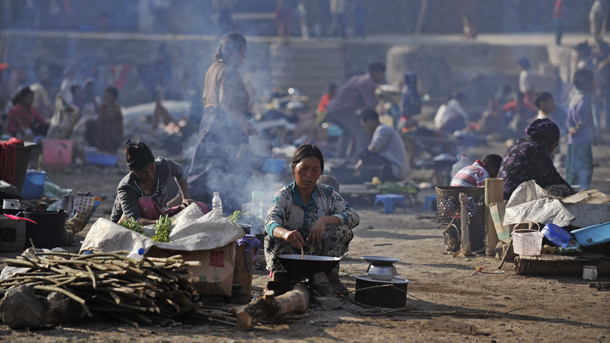
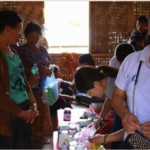
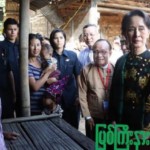
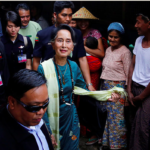
![‘Not Only Do They [Burma Army] Aim Their Weapons Against Civilians, They Also Rape the Women’: Ah Ze, General Secretary of AKYU — PART 1](https://www.burmalink.org/wp-content/uploads/2018/10/Ah-Ze-speaking-at-AKYU-anniversary-150x150.jpg)
